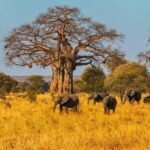- Arusha, United Republic of Tanzania
- info@olodiafricanpathways.com
- +255 787 052 187
Olodi African Pathways Photography

Tarangire National Park
Tarangire National Park has the largest concentrations of elephants in the world, giant Baobab trees, beautiful landscapes, lions, leopards, cheetahs, monkeys and it’s a true paradise for bird lovers.
Tarangire National Park
Tarangire National Park is known for its majestic Baobab trees. These can grow to an enormous size and have a unique shape. The Park is also famous as it has the largest concentration of elephants in the world! You can see herds of up to 300 elephants around the Tarangire River. The River is the primary source of fresh water for the animals. In the dry season, they come here to drink or just to enjoy a bath to cool off from the hot sun. During the end of the dry season, elephants dig into the riverbed to reveal underground water or are looking for Baobab trees to slake their thirst.
Elephant paradise
Apart from elephants, Tarangire is a paradise for bird lovers. From parrots, hornbills, lovebirds and lilac-breasted rollers to Kori bustards, eagles and vultures. The swamps in Tarangire National Park have one of the largest numbers of breeding bird species in the world. In the area around these swamps, you can also see lions, leopards, cheetahs and even tree-climbing pythons.
Authentic atmosphere of Tarangire
Tarangire is one less-known park in Tanzania, but it still has an authentic safari atmosphere. The hilly landscape scattered with huge Baobab trees against the blue sky is breathtaking.
Most common animals in Tarangire National Park
- Elephants (big herds)
- Giraffes
- Zebras
- Wildebeest
- Ostriches
- Leopards
- Lions
- Cheetahs
- Birds
- Pythons
- Monkeys
- Buffaloes
Excursions and activities in Tarangire National Park
Tarangire facts
Herds of elephants and other wildlife gather around the Tarangire River The park is dotted with thousands of giant Baobab trees. Some are over 300 years old Grassland plains also known as “Small Serengeti” Stunning views of Lake Burungu, an important water source in the park. Scenic landscape Largest termite mounds in Tanzania
Best time to visit Tarangire
Tarangire is a great year-round park for game viewing. Especially during the dry season (June – October) when animals gather around the main water source in the area, the Tarangire River. Lots of animals migrate out of the park during the rainy season (April-May) due to the black cotton soil that’s bad for their hoofs.6
- Visit Hadzabe tribe
- Cultural tour Mto wa Mbu
- Mountainbike tour Lake Manyara
